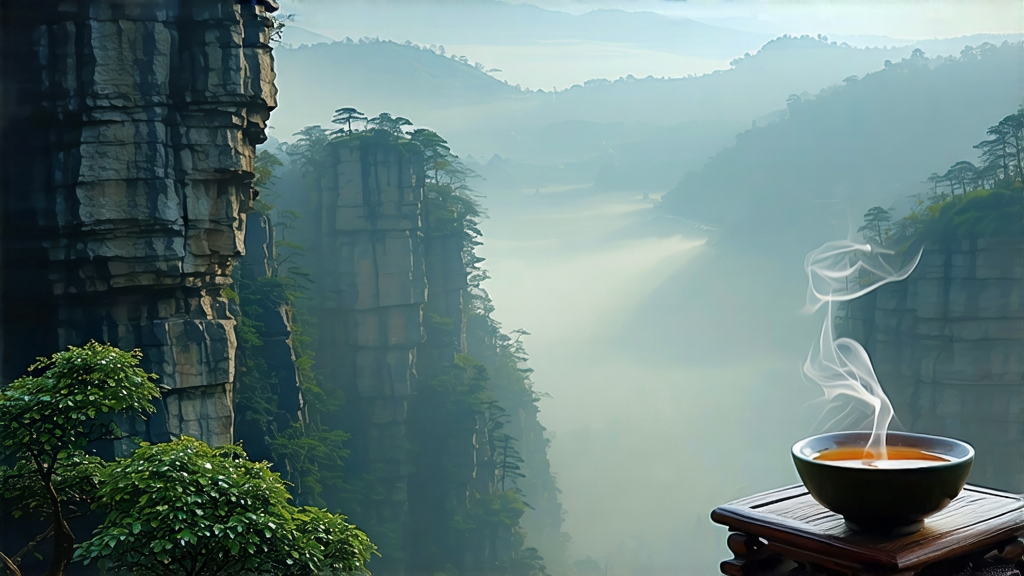
If green tea is China’s springtime whisper and pu-erh its autumnal soliloquy, then Da Hong Pao—Big Red Robe—stands as the mountain’s eternal aria, a cliff-hung oolong that has sung across six centuries. Born in the vertiginous Wuyi Shan of northern Fujian, this tea carries the minerality of weathered granite, the perfume of pine-smoked air, and the folklore of an imperial scholar whose life was saved by its leaves. To the international drinker it offers neither simplicity nor instant gratification; instead it promises a slow geological dialogue between rock, mist, fire, and time.
History: from imperial tribute to spacecraft
The first written record appears in 1385, when a Ming dynasty scholar, recovering from fever in Wuyi’s Nine-Dragon Gorge, was revived by monks who brewed leaves plucked from four stunted bushes clinging to a crevice. Grateful, the scholar draped his vermillion imperial robe over the plants—hence the name. By the 17th century the Qing court had classified the original bushes as “imperial tea,” sending their entire harvest—often less than 200 g—by relay horse to Beijing. In 1972 Mao Zedong presented 50 g of mother-tree Da Hong Pao to U.S. President Nixon, quietly signaling diplomacy; in 2005 the last 20 g plucked from those 350-year-old plants sold at auction for ¥208,000, after which the Chinese government declared them off-limits. Cuttings had already been grafted onto lower-elevation terraces, so today what reaches the market are “queen-tree” or “commercial” versions, genetically identical yet grown on gardened slopes rather than vertical stone.
Micro-terroirs: why “rock rhyme” matters
Wuyi’s Danxia landform—iron-rich sandstone and tuff eroded into knife-edge ridges—creates a terroir the Chinese call yan yun, “rock rhyme.” Rainwater filters through fissures, picking up potassium and fluoride, then evaporates as mist that keeps the ambient humidity above 80 %. The stress of shallow soil forces roots to probe crevices, concentrating polyphenols and aromatic volatiles. Within the 60 km² UNESCO core zone, micro-valleys are further classified as “positive rock” (south-facing, full sun, brisk aftertaste) or “negative rock” (north-facing, softer texture, orchid nose). The most coveted plots—Nine-Dragon Gorge, Sky-Crawling Peak, Ghost Cave—yield fewer than 300 kg of finished tea per hectare, less than one-third of a flatland plantation.
Cultivars: four bushes, one name, many faces
Although “Da Hong Pao” is a brand, processors blend up to ten indigenous Wuyi cultivars to recreate the mother-tree profile. Key actors include:
- Qi Dan: the closest genetic match, small leaf, cinnamon-spice note.
- Bei Dou No.1: cold-resistant, planted on higher ridges, plum aroma.
- Rou Gui: naturally cinnamon-bark character that anchors the blend’s middle palate.
- Shui Xian: large leaf, thick cell walls, gives body and lingering rock sweetness.
The art is to balance fire, fragrance, and mineral backbone, much like a Bordeaux vigneron assembles cabernet with merlot.
Craft: the 13-hour odyssey from leaf to memory
Plucking begins at dawn when the sun has burned off surface dew yet before the valley thermals rise. Two leaves and a bud are snapped with the fingernail to avoid the oxidizing bruise of scissors. The load is carried in bamboo baskets lined with linen; any compression at this stage will translate to “dead leaf” aromatics later.
Withering is split into two acts: outdoor “sun wither” for 20–30 minutes on raised rattan trays, then indoor “cool wither” on water-heated troughs at 28 °C for another 2 hours, during which leaf temperature must never exceed 32 °C. Turners gently shake the trays every 15 minutes, coaxing water to migrate outward without rupturing cells.
Oxidation is the soul moment. Leaves are piled 8 cm deep in bamboo drums and rolled by foot-powered bamboo machines that mimic hand-tossing. Over 50 minutes the edges bruise, turning russet while veins stay green; oxidation halts at